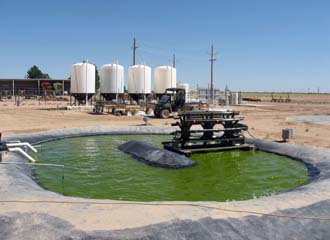 |
The National Alliance for Advanced Biofuels and Bioproducts (NAABB) is a consortium of government laboratories, universities and private industry headed by the Los Alamos National Laboratory. The consortium is developing new technologies and processes to produce fuel and useful chemicals from algae economically. The consortium is working on methods to harvest algae more efficiently from growth ponds and to modify the organisms to increase the amount of fuel that can be extracted. |
Efforts are underway to develop algae-based biofuels. Scientists are developing methods to turn green algae into black gold. A research consortium consisting of two national laboratories, universities and private industry is studying a variety of technologies and processes to convert the humble one-celled organism into the chemical building blocks for biofuels and plastics.
Led by the Los Alamos National Laboratory, New Mexico, the goal of the National Alliance for Advanced Biofuels and Bioproducts (NAABB) is to develop new methods to make the algal biofuels industry successful. According to Jose Olivares, biofuels program lead at Los Alamos and executive director of NAABB, the group is targeting technologies through the entire process chain from logistics to feedstock preparation, conversion and distribution.
Olivares notes that Los Alamos’ biological sciences program dates from the early years of nuclear weapons research. The laboratory originally studied the effect of radiation on the environment. Over the years, this evolved into a robust biological sciences program with some 300 people in the bioscience division and with specialists located in the laboratory’s chemistry, physics and theoretical science divisions.
The consortium grew out of ongoing U.S. Department of Energy (DOE)-sponsored research into developing methods to harvest algae as fuel (SIGNAL Magazine, April 2007, page 71). In 2008, the DOE launched its Algal Biofuels Roadmap, which was an effort to create a consortium focused on developing commercially viable processes for harvesting oil and biomass from algae. Olivares explains that Los Alamos actively participated in organizing its consortium and convincing other organizations to join in. He observes that beginning in 2009, Los Alamos recruited regional schools such as the University of New Mexico, the University of Arizona and Texas A&M. NAABB now consists of 17 universities, 14 companies, the Pacific Northwest National Laboratory and Los Alamos.
Under the NAABB, Los Alamos is conducting a range of programs with its own funds and with the backing of the DOE. Among these efforts, laboratory researchers are developing low-temperature catalytic systems to convert sugars into high-density fuels. Breaking down sugars from material such as cellulose or starches found in plants and algae permits the biomass to be converted more easily into fuel. Current methods require heat and pressure and consume large amounts of power. Olivares admits that there is some product development in this process—products being any chemicals originating from the research that can be applied to various industries such as feedstocks for plastics. The laboratory’s work with catalysts also has generated a cooperative research and development agreement with Procter and Gamble to find new applications for the technology in the plastics industry. He notes that renewable feedstocks from plant-based materials such as cellulose could replace the petroleum-based feedstocks that are used in industry.
Another similar effort is the development of catalytic systems to break down lignin, a material in plants that holds cellulose together like glue. Olivares notes that lignin has a very rich and complex chemical structure. Lignin also is somewhat “sticky” and produces gumming and other adverse effects downstream in the production process. Normally, lignin must be degraded or removed from the process in some way, he says. However, Los Alamos researchers are developing methods to break down lignin into basic and useful chemical components that can be used during fuel production.
Los Alamos scientists also seek to understand how algae metabolism regulates nutrients. For example, one of the main nutrients for algae is nitrogen. If scientists can understand the intricacies of how algal cells absorb nitrogen and convert it into amino acids, they potentially can control the process to add more biomass or lipids to algae. “I think the whole [biofuels] community recognizes it as the biggest bottleneck for the algal biofuels initiative,” Olivares maintains.
A related part of the algal biofuels program is modifying algae to produce high-value chemicals. Olivares explains that some algae produce molecules called keratinoids that are valuable chemical products used in foods and dyes. He notes that Los Alamos researchers have developed prototype technologies that may allow algae to produce specific chemicals on demand.
 |
In addition to fuel stock, NAABB scientists are developing methods to extract useful chemicals from algae. These materials, such as cellulose and the lignins that hold it together, can be made into feedstocks for plastics and other materials. |
Los Alamos
researchers are working to understand how cellulose degrades chemically. This knowledge would greatly increase the efficiency of a number of algal and biomass-related fuel programs. To observe these effects closely, scientists are using advanced devices such as linear accelerators to study phenomena such as neutron scattering on cellulose molecules and how hydrogen bonding serves to keep cellulose together. During this study process, researchers introduce a chemical to degrade the cellulose to observe how the material unravels. Olivares adds that additional tools his scientists use to measure the breakdown of cellulose are imaging microscopy devices and high-energy X-ray diffraction devices. Researchers also are developing technologies to track single enzymes of cellulose. Called single molecule detection technology, this capability allows an enzyme to be tracked as it consumes a chain of cellulose. Olivares notes that this work requires extensive computer modeling. Los Alamos is using its supercomputers to create models and simulations of protein interactions that will help scientists better understand these structures and potentially modify them.
Another technology created by NAABB for work with algae is called acoustic focusing, which allows algae to be harvested more efficiently. This technology was developed to scan and study the insides of munitions. He says that several years ago, scientists modified the technology to develop a method for flow cytometry, which allows particles to be focused acoustically in a flow stream without additional hydrodynamics. This technology now is being applied to algal biology research to help overcome an important hurdle to industrial-scale algae production—harvesting the algae and extracting the oils to make biomass and feedstock for biofuels.
Using current methods, when algae is harvested, roughly one gram of material is collected for every thousand milliliters of water. These very low concentrations of biomass create challenges, especially in separating the water from the algae. “It takes a lot of energy to actually take out the water and retain the algae,” he says.
Current methods to separate algae include centrifuges, filters and presses, and they are energy intensive. Olivares notes that Los Alamos researchers have demonstrated that acoustic focusing technology can be used to concentrate algae for efficient, low-energy harvesting.
Olivares explains that these research initiatives have directed Los Alamos’ biological research capabilities into the biofuels area. Within the NAABB, Los Alamos is contributing research and technologies for harvesting and extracting biomass. Los Alamos researchers also are contributing in the area of conversion, taking algal fats, or lipids, and catalytically converting them into fuel.
Algae use carbon dioxide as a nutrient. Consortium scientists are exploring methods to concentrate carbon dioxide from atmospheric and other sources to feed algae. Another closely related area of study is water, both as a resource and a carrier for nutrients. Because algae use a great deal of water to grow in, Los Alamos’ environmental, Earth sciences and chemical sciences divisions have launched a project to study water quality issues and hydrology associated with underground water reservoirs. Olivares explains that there is a severe lack of surface water in the arid Southwest United States. However, many reservoirs of saline or minerally tainted water exist that are unfit for human consumption or agriculture but that can be used for growing algae.
Scientists also are examining other water sources such as water used in oil drilling and water that wells up from the ground during the oil extraction process. This water has a high mineral and chemical content and is very toxic. Olivares adds that such water must be carefully disposed of at great cost to the oil industry.
NAABB researchers led by Los Alamos are developing methods to grow algae in these toxic types of waters. Olivares explains there is a great advantage to using industrial and municipal wastewater, and green water from cattle and milk industries to grow and feed algae. “If you select the right strains [of algae] and you can introduce the right waters in the right conditions, you can actually use the algae to consume and use as a nutrient a lot of the components [in the water] that would otherwise be a major environmental issue,” he explains.
The NAABB has several key research components: algal biology, cultivation, harvesting and extraction, conversion, animal feed, sustainability and energy efficiency. Olivares remarks that each of these areas has a number of milestone deliverables due over the next three years. The goal is to develop technologies in each of these areas that can be applied commercially by the consortium’s industrial partners.
The consortium not only seeks to determine if these areas can be made viable, but also to develop new technologies to make them viable. If a possibility of viability exists, the final step is to mature the technology into a commercial process. “If we can put a few technologies into the processes that our commercial partners are putting together and influence their efficiency, economics, environmental impact and environmental sustainability, then we’ll have success,” he says.
Web Resources:
National Alliance for Advanced Biofuels and Bioproducts: www.arl.arizona.edu/naabb/
Los Alamos National Laboratory: www.lanl.gov






Comments